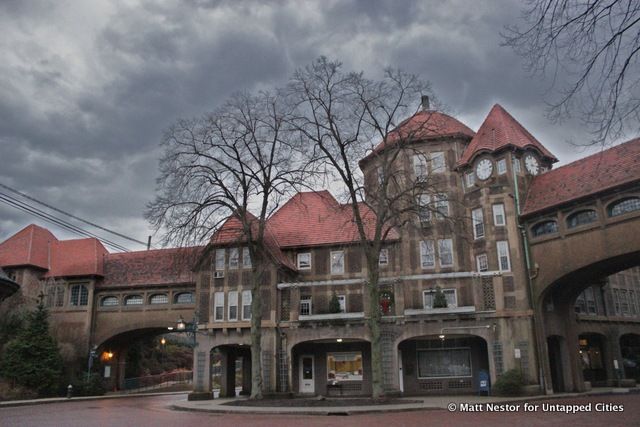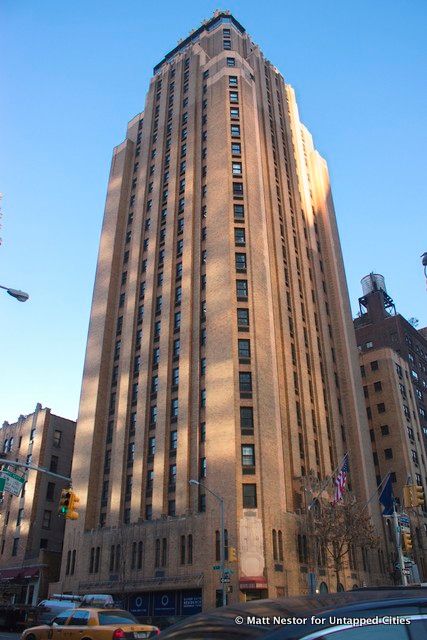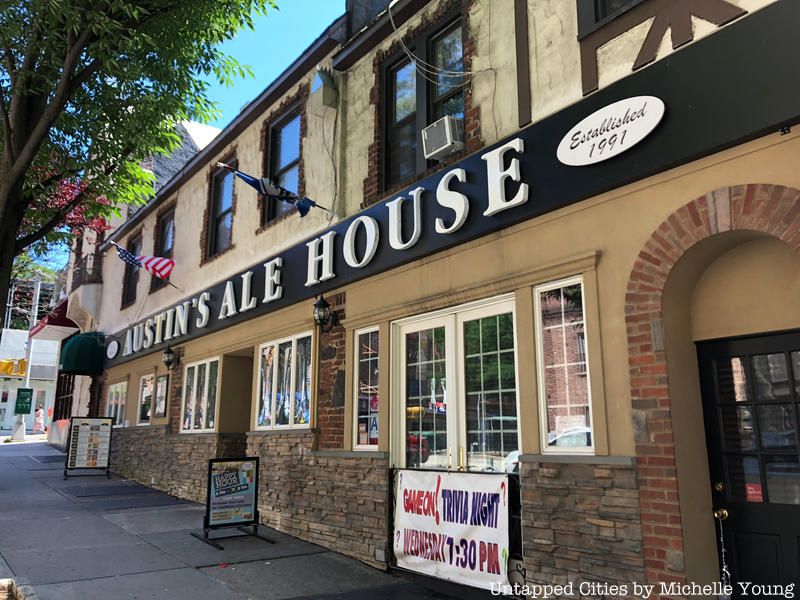Last-Minute NYC Holiday Gift Guide 🎁
We’ve created a holiday gift guide with presents for the intrepid New Yorker that should arrive just in time—


New York has become one of the safest big cities in America, but it has a colorful history as far as violent crime is concerned. This week we visit some of the city’s more picturesque settings for slaughter (and no, we’re not including The Dakota).

Walk down busy 71st Ave and under the Long Island Railroad overpass at Forest Hills and you’ll suddenly emerge into Station Square, a brick-paved open space modeled on a medieval town center. A unique public area, the square is completely enclosed by brick and stucco buildings and arching pedestrian overpasses. External half-timbering and tile-roofed towers complete the visitor’s impression of having just stepped out of a time machine.
In other words, it’s not a half-bad place to take a date. John Diel and Christine Freund were sitting in the square one winter night in 1977 when three huge .44 caliber shells smashed the windshield of Diel’s car. He survived, but Freund was hit twice and died within hours. The perp? None other than David Berkowitz, aka Son of Sam. The Station Square attack to be a turning point in the case, as the slugs recovered from the scene helped police conclude that they were, in fact, dealing with a serial killer. Son of Sam terrorized New York until August of that year.

This 26-floor brick hotel at 3 Mitchell Place near the UN, finished just before the onset of the Great Depression, has all the hallmarks of the exuberant Art Deco style. Bold symmetrical lines extend the length of each side, ending in a step pyramid roof composed of strong geometrical shapes.
Beekman Tower was intended for ex-sorority girls, but somehow the Nazi-sympathizer (and personal friend of Hermann Goring) Fritz Gebhardt wrangled an apartment in 1935, putting him just two floors above ex-girlfriend Vera Stretz. Vera loved him but was leaving for Paris soon “to forget”; still, she would come up and nurse him during his frequent attacks of abdominal pain. Having summoned her one night under this pretense, Fritz raped her and then, worse yet, demanded fellatio. Oral sex was a felony in New York State at the time; Vera’s lawyer argued that by shooting Fritz with his own gun, she had forestalled her own complicity in a serious crime. The jury acquitted her on all counts.

When Carlyle Harris gave his young wife Helen Potts a morphine overdose in 1892, he made the fatal mistake of failing to account for the contraction of her pupils, a dead giveaway of narcotic poisoning. Even so, he might’ve got away with it if it weren’t for muckraking journalist ‘Ike’ White, who had the body exhumed and tested for morphine. A year later, a man came to the reporter’s office, asking Ike once again to pick up where the police had left off. His employer, the rich madam Annie Sutherland, had died suddenly and her husband, Dr. Robert Buchanan, had upped the stakes and remarried his first wife in Nova Scotia. Did Ike care to investigate?
The attendant physicians told Ike that Annie’s pupils were considerably dilated when Annie died, causing them to rule out morphine poisoning. But an unsatisfied Ike began to frequent Buchanan’s old haunt, Macomber’s bar. Having spent several weeks, and several hundred dollars, at the dive (now a Chinese restaurant), Ike got what he wanted: one night, a drunk Buchanan had asked him, “Have you ever been to the eye doctor? Have you had drops put in your eyes? Well, the drops are belladonna. Atropine, in other words. They enlarge the pupils.”
Once again, Ike had a body exhumed. Once again, it turned out to be chockfull of morphine, though this time a fair sprinkling of atropine enlivened the mixture. Buchanan went to the chair on July 1, 1895.
Annie Sutherland’s whorehouses were in Newark, but she kept (and died in) a basement apartment in the classic West Village brownstone at 267 West 11th Street.

We laugh now at the terror invoked by the so-called “Red Menace,” or shake our heads at the careers curtailed by Hollywood blacklisting and HUAC, but there was a time when leftist radicals were seriously terrifying. 1919 saw a wave of bombings, from the mailed explosive package that took off the hands of the secretary to the commissioner of immigration, to the street bomb that killed two passersby outside the house of then Undersecretary of the Navy Franklin Delano Roosevelt.
These were nothing compared to the tremendous bomb that went off on the corner of Wall Street the next year. Porters had just finished carrying bullion into the Subtreasury Building (now the Federall Hall National Monument Courthouse, aka the building in “Night Court”) and were sitting down to lunch when a huge bomb detonated in a horse-drawn wagon in the street below, sending five hundred pounds of shrapnel flying in every direction and breaking windows for half a mile around. Thirty-eight people died in the blast, including millionaire Edward Street, of whom nothing remained but a pinky digit and a signet ring.

Though the press was quick to finger leftist terrorists, no one was ever charged for the blast. The old J.P. Morgan building on the corner of Wall and Broad Streets bears the marks of the explosion to this day: inch-deep craters pockmark the lime stone beneath the second window sill from the building’s east end.

Perhaps no one would call this address in Kew Gardens an architectural knockout, though Austin’s Ale House, with its half-timbering, wood paneling, and upper stories of stucco and brick-framed windows are happily reminiscent of a classic British pub (even if the profusion of plastic ad signs are not). But one still feels awe when treading this block, especially when peering up at the huge apartment building opposite. Thirty-eight people supposedly had flats overlooking the street in 1964—thirty-eight people, and not one called the police.
It is a well-known story: Kitty Genovese, returning from work late one evening, was stabbed outside her apartment by family man (and psychotic serial killer) Walter Mosely. She cried bloody murder, someone yelled from a window, Walter walked away—and returned a few minutes later to stab her again. Then he actually got in his car and drove a fair distance before hanging a U-turn and returning a third time to the block, still empty of police. He followed the crawling Kitty into her building vestibule before finally departing for good. Only then did someone call the cops. A cruiser showed up within two minutes, but it was too late: Kitty was dead, having asphyxiated from a pierced lung.
Though this is far darker than our usual fare at Untapped Cities, you can read more in this vein in our 2-part series on Notorious Crime Scenes in NYC (Murders & Suicides) and Part 2 on Heists, Bombings and Bank Robberies.
Get in touch with the author @TheDailyVirgin1
Subscribe to our newsletter